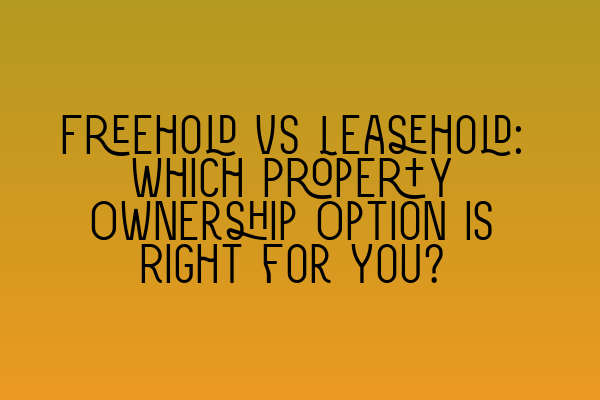Welcome to the SQE Property Law & Land Law blog! In today’s post, we’ll be exploring the two primary forms of property ownership in the UK: freehold and leasehold. Whether you’re a prospective homebuyer, property investor, or simply someone with an interest in the subject, understanding the differences between freehold and leasehold is crucial.
Before we dive into the details, it’s important to note that this post is for informational purposes only and should not be construed as legal advice. If you have specific questions or concerns about your property ownership options, we recommend consulting with a qualified solicitor.
The Basics: Freehold and Leasehold Explained
The terms “freehold” and “leasehold” refer to the legal rights associated with a property ownership. Let’s take a closer look at each:
Freehold
A freehold property refers to full ownership of the land and the building on it. Essentially, when you purchase a freehold property, you become the outright owner. This means you have complete control over the property and can make decisions about its use, alterations, and maintenance within the limits of the law.
Freehold ownership is typically associated with houses, bungalows, and some types of flats. With a freehold property, you are not subject to ground rent or service charges, and you have the potential for greater control and flexibility.
Leasehold
Unlike freehold, leasehold ownership grants you the right to occupy a property for a specific period of time and under the terms set out in a lease agreement. In most cases, leasehold properties are flats or apartments where multiple units are owned within a larger building or development.
When you purchase a leasehold property, you effectively become a tenant with a lease agreement between you (the leaseholder) and the freeholder (the owner of the land). The lease defines the length of ownership, any ground rent or service charges payable, and the rights and obligations of both parties.
It’s important to note that leasehold ownership comes with certain restrictions. As a leaseholder, you may need permission from the freeholder for alterations, subletting, or even keeping pets. Additionally, you may have to renew the lease when it expires, which can incur costs.
Factors to Consider: Freehold or Leasehold?
Now that we’ve covered the basics, let’s explore some factors to consider when deciding between freehold and leasehold:
1. Control and Flexibility
If having complete control over your property is important to you, freehold ownership may be the preferred option. With a freehold property, you have the freedom to make decisions without seeking permission from a landlord or freeholder.
On the other hand, leasehold properties often involve a degree of shared responsibility and decision-making. Major alterations or changes to the property may require consent from the freeholder or involvement from a management company.
2. Costs and Responsibilities
When comparing costs, it’s crucial to consider not only the initial purchase price but also the ongoing expenses associated with owning the property.
With freehold ownership, you are responsible for all maintenance and repair costs. However, you have the freedom to choose how and when these tasks are carried out.
Leasehold properties, on the other hand, typically require payment of ground rent and service charges to the freeholder or a management company. These charges can vary greatly, so it’s important to review the terms of the lease and understand the financial implications involved.
3. Length of Ownership
Another factor to take into account is the length of ownership you desire. Freehold ownership provides indefinite ownership, allowing you to pass the property on to future generations or sell it with minimal restrictions.
Leasehold ownership, however, is time-limited. Leases for residential properties are typically long-term, often lasting 99 or 125 years. While this may still be sufficient for many homeowners, it’s important to consider the potential costs and complexities of lease renewal when the time comes.
4. Location and Property Type
The availability of freehold or leasehold properties may vary depending on the location and the type of property you’re interested in.
In urban areas, especially city centers, leasehold properties are more common due to the limited availability of land. Flats and apartments tend to be leasehold, while houses may have both freehold and leasehold options available.
It’s important to research the local property market and understand which ownership option is more prevalent in your desired location.
Conclusion: Which Option is Right for You?
Ultimately, the decision between freehold and leasehold ownership depends on your individual circumstances, preferences, and priorities.
If you value complete control, long-term ownership, and minimal ongoing costs, freehold ownership may be the better choice.
However, if you’re looking for a more affordable entry point into the property market or you prefer a hassle-free lifestyle where maintenance responsibilities are shared, leasehold ownership could be the right fit.
Remember, it’s always advisable to seek professional advice from a solicitor specializing in property law before making any decisions.
For further reading on relevant property topics, we recommend checking out the following articles:
- Updates in UK Property Laws: Key Changes and Implications
- Legal Challenges in Property Transactions: A Comprehensive Guide
- Navigating Lease Laws in the UK: Essential Guidelines for Tenants and Landlords
- Dominate Property Law Questions: Avoiding Common Pitfalls
- Land Law Revision Tips: Ace Your Exam Preparation
Thank you for visiting our blog, and we hope you found this post informative. If you have any questions or would like to discuss your property ownership options further, please don’t hesitate to contact us at SQE Property Law & Land Law.
